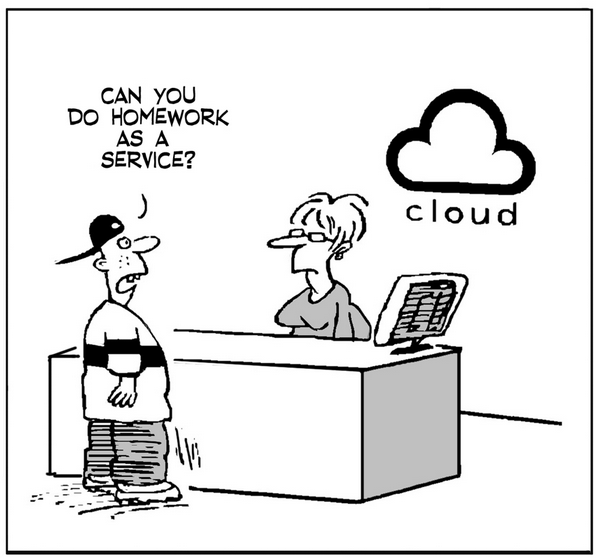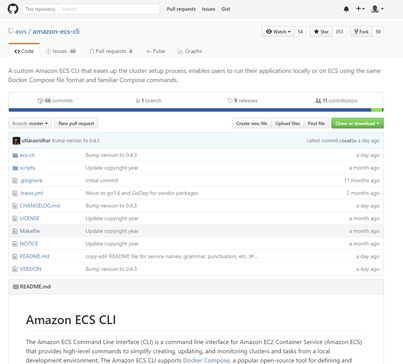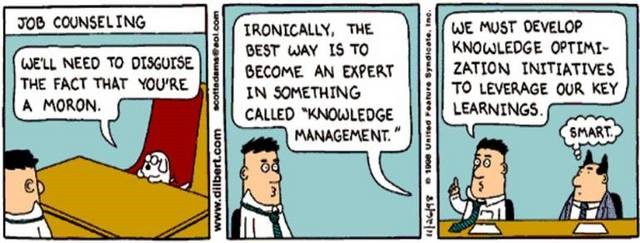Recently, I was asked a question: how do you create a sustainable knowledge management? The answers that they previously got apparently were on these lines: of different knowledge management systems, the processes, the governance, the artifacts they would produce and the structure of the dedicated team that works on this knowledge management. Mind you, this was not a project on knowledge management, but a program that the client was getting into. They thought that they would knowledge management for that.
There is nothing to blame the answer. Years of management learning taught us that if we want to solve a problem, hire people to do it, allocate resources to it, and show commitment to it. In fact, we talk about how do “organizational change management” (OCM).
Sure enough that there are examples of such cases. Famously, IBM showed [how it can create new systems and support it](https://www.amazon.com/Who-Says- Elephants-Cant-Dance/dp/0060523808). Microsoft reinvented itself in the internet era – by doing exactly the same, in creating a new focused division.
Yet, in this case, this answer is entirely wrong. Unless the company is in the business of knowledge selling, knowledge management systems will fail. This kind of approach fails when the focus in not meant to be knowledge management. This problem is particular in lot of knowledge sharing applications, collaboration systems, training systems, and so on.
The general explanation that people give is that the designers failed in creating the right programs. That they focused only on computer systems and neglected OCM. Or, that they did not allocate enough money for support.

(© Scott Adams)
All of these reasons are correct, yet not really completely correct. There is a reason why lot more money is not allocated – the management does not see the ROI. Or, there is a reason that they neglected OCM – this was not the focus.
So, do we say that these systems are not important? Can we make them important? Or, should we even make them important?
Let us look at this issue in depth. As organizations are trying to become digital, they recognize the importance of these kind of supporting systems and yet do not know how to make them succeed. They work about bringing lot more consultants to change the organizational culture and continue to fail. Therefore, it deserves more in-depth understanding.
Theory of sustainability
In the beginning, in the question I was asked, there was a key word: "sustainable". We normally see that word in ecology, architecture, and social studies. There, people talk about enduring systems, systems that replenish themselves, systems that do not require external stimulus to support themselves. Normally, in ecology, people talk about the footprint of the systems: the effort it takes to create a system, maintain a system and so on. To make a system sustainable, we want to make sure that it has low footprint, and it does not depend on somebody's explicit effort to keep it going.
For example, let us look at sustainable architecture: it means the footprint of the architecture is low. It can sustain itself – perhaps through low energy usage and perhaps with solar power. Also, it may recycle water. It may reduce wastage. All of these metrics mean that it does not take much to maintain the architecture. For example, in my village, these thatched houses are built with crossflow ventilation and open spaces. These days, the modern houses are built with bricks with window A/C units. Come summer power cuts, the modern houses are unbearable, whereas the old houses are merely uncomfortable. It is same with urban design also, when the it is harmonious with nature, it is easy to sustain. Most cities cannot sustain themselves without lot of effort these days into the roads, parking lots, public transportation, sanitation, and water services. Imagine that we build cities for people! We may be able to make them sustainable.

[See the contrast between two designs: the first one relies on parking spaces – it needs more and more parking space as it needs more and more space and only cars can traverse the distance. The second one is built for people, where walking is the way to get around. It works because it needs less space. Pictures courtesy: http://www.andrewalexanderprice.com/]
Surely, we can take lessons from these systems in designing our knowledge management system? Designing for people with low maintenance or no maintenance? Or, working with the way people do, instead of trying to change them? Working with the existing culture instead of imposing a new culture? Making “nudge” like social experiments instead of, say great leap forward?
These are hard questions, with no definite answers. Yet, we can make an attempt at understanding the role of sustainable systems in IT and key elements to creating such systems.
Three kinds of IT systems
Let us say that a bank is getting into new business of serving mass affluence customers. Historically, they served only the customers with 10 million dollars or more. Now, they want to extend the same services to people with 250K. Let us say that the organization is building a new division to support this initiative.
Even if it sounds easy, this is a difficult task. Firstly, the employees are used to handhold the millionaires. They are used to bypass the processes to cater to the super rich. Now, that they are working with regular rich folks, their old ways cannot scale to the new numbers. And, their compensation earlier may depend of different metrics: handling a few HNI. Now, they have to use different metrics – may be total money under management. The systems they use are going to designed for most common used.
Let us confine ourselves to the computer systems (and supporting processes) to run this division:

Let us see what these systems do and where sustainability may make a big difference.
Core systems
Without these core systems, the business doesn’t even run. The management makes sure that the focus is on these systems. These systems run with stringent SLAs, with adequate funding, and often with milestones, bonuses, and penalties. These metrics are very closely aligned to business metrics. These systems do not need to be sustainable – there is enough support to sustain them by providing external stimulus.
However, there can be a case to make the architecture of these systems sustainable. Often these systems are rewritten to support changes in business. These rewritings can be expensive and may cause delays in the ability to respond to the markets. If we make the architecture sustainable, then we can make changes to the system without causing major changes to the core part of the architecture. For instance, if we have good modularization, good interfaces, and coherent philosophy of data, we can extend the existing architecture without any changes. For instance, see how Unix endured for the last 50 years, without fundamental changes.
This kind of “built-for-change” architecture can make core systems resilient to change – and can create sustainable architecture.
Required support systems
The required support systems are not part of the core systems. But, to run the core systems we need these systems. The metrics on these systems, the SLAs and how well they are run, do not directly translate to the main core metrics. Yet, they are important, like insurance. For instance, if security is a problem, you would hear about it. If operations is a problem, you would again hear about it. If there are no problems, the chances are you won’t hear about these systems at all.
One interesting aspect is that these systems are very similar across different businesses. For example, would the HR be that different for a bank, from say, a retail company? The chances are that they can get away with using the computer systems that are generic – say software as a service in the cloud. Or, even better yet, they can even outsource most of these functions to outside. Cloud fits in here very well, either as a full end-to-end service offering or a partial service offering.

(from: http://founderdating.com/marketing-changing-saas/).
Since these systems are mandatory, even if there is no direct business value, IT is often measured on these systems. Because of this reason, these systems do not need to be self-sustaining. Still, since these are not core to the business, very rarely do companies want to innovate in these systems.
Optional support systems
These systems are what management talks about in the vision. For example, when a company says that employees are the best assets, these are the systems supposed to increase the value of that asset. Every visionary program talks about how these systems are created and maintained.
And, yet, these are the systems that end up failing often.
Since these are not in the way of core delivery, even if these systems fail, nobody raises alarms. They are like the climate change harbingers. A few polar bears dying? Not a mainstream concern! Yet, we all know that without these systems, modern digital enterprise cannot survive.
Why did I make such a bold statement? Take a look at the models of the modern digital enterprise: Google, Facebook, Netflix and such. Almost all of these place a lot of emphasis on hiring, creating, and nurturing talent. They take these optional systems and turn them to competitive assets so much so that most companies that want to be digital, want to emulate them on these aspects. The whole idea of innovation labs or devops, or 2-speed IT, or data driven organizations take these practices as a way of creating such dynamic organizations.
For an organization that wants to see these optional support systems as a core strength need not look at digital enterprises alone. They can look at open source ecosystem, where these optional systems are well developed and sustained. For instance, in open source world, if a volunteer joins a new software development effort, how does he go about it?
- He can read the code and documentation on github.
- He can read the old notes or discussions on mailing list archives or google groups.
- He can participate on the slack channels.
- He can fork the code
- He can fix some simple issues and contribute back
- He can enhance the documentation.

In short, without taxing any resources, he can become a productive member of the team. In fact, these are the salient features of this development process that makes it sustainable:
- All the optional systems are baked into the required systems: the knowledge management is a part of version control system.
- The optional systems are simple. For instance, most of the documentation is written in markdown. It is a part of the source code. It is not elaborate, but quick to the point of boot strapping.
- It welcomes contributors. The process of forking and contributing code is simple. In fact, the first think people handle is this simplification, before they set the project up in github.
- If the leadership changes, the entire project can be cloned. There is no hidden information.
In contrast, in an enterprise, this is how it might be:
- A local, special toolset that forces people to learn before they contribute
- A special team who is supposed to maintain onboarding documentation, which often is out-of-date,
- If one has to contribute to the project, it will take handholding of an existing (often busy) team member
- No quick gratification for the new comer – which means there is no incentive for new comers to join the program.
In short, the open source way is sustainable because it is simple, it is welcoming to new comers so that they can sustain the system.
Sustainable organizations
The same principles work in creating organizations as well. Most organizations focus on customers and deliverables, which contribute to the direct metrics. The indirect metrics that enable these metrics in the long term may be focus for a while, but the moment they become less important, they fall by the way side. Because they are not sustainable, there is every danger of them becoming a wasteland of systems with lip service.
Most organizations do realize this problem. Their solution is to increase the focus on this problem. But, that does not solve the problem forever. Instead, it becomes like US medical healthcare. The joke is that people with rich plans end up getting bad treatment, as everybody wants to treat them for something. And, people with no insurance also end up getting bad treatment. Only with just the right kind of insurance, will we get the right treatment.

By Arshiya Urveeja Bose - Flickr, CC BY 2.0
The idea is the focus should be creating such sustainable systems – the systems that can run without continued focus. These systems should run, as a byproduct of the main metrics. They should run because the traditions established. They should run because they serve selfish interests of people. They should run because the collective interests of the people to force others to confirm.
Checklist for sustainable systems
We started with the knowledge management system and how to make it sustainable. I never gave any answer to that question. Instead, I went on to explaining sustainability. Now, let us get back to sustainable knowledge management system. While we cannot define it, we may be able to help in creating a checklist to see if a system is sustainable. Obviously, we want it to be of low footprint, but that is not enough. The following check list may be a good start.
- In the steady state the system should not require any additional resources to support it.
- Until it gets to the steady state, the stakeholders should commit to it.
- The system should automatically keep itself relevant.
- It should be in the interests of an individual to use it.
- It should be in the interests of an individual to contribute to it.
- It should be in the interests of the team to use and maintain it.
- It should be easy to get started with the system.
- It should not contradict existing modes of working.
 (© Scott Adams)
(© Scott Adams)
These kind of systems can be sustained in the long run. If we are building a sustainable knowledge management, this is the list we should check against.
Or, go with knowledge optimization initiatives to leverage our key learnings, as Dlibert says :-).